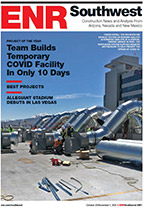The proposed $6-billion, DesertXpress high-speed passenger train project recently cleared its first major hurdle with the March 24 release of its final environmental impact statement. Circle Point, San Francisco, prepared the report on behalf of the Federal Railroad Administration. A record of decision is expected this spring.

DesertXpress will follow the Interstate 15 alignment between Victorville, Calif. and Las Vegas, using existing right-of-way either along the median or roadside, and will build two passenger stations, a maintenance-storage-operation facility and three electrical substations. The project’s overhead catenary electric powered trains will travel up to 150 mph, using off-the-shelf steel wheel technology.
DesertXpress is supposed to divert 3 million automobile trips annually, about 22% of total traffic, from a 186-mile stretch of I-15 that has lacked passenger train service for 14 years. Amtrak shuttered its 18-year-old Desert Wind route in 1997 due to low ridership. Traffic between Victorville and Vegas is estimated to reach 75,000 vehicles a day in 2015, the EIS says, eventually increasing by 25% in 2025. The line potentially could be extended 50 miles west to Palmdale where a station is planned for the future state-wide California High Speed Train system.
DesertXpress will initially consist of 14 to 16 Bombardier Zefiro trains, each carrying 675 passengers. A one-way trip would last 1.24 hours and cost $50. Construction is expected to take three to four years, and create 35,000 jobs, project backers say.
In 2009, Senate Majority Leader Harry Reid (D-Nev.) swung support from a proposed maglev line to DesertXpress because it wasn’t “seeking any federal funding,” among other reasons. The project’s price tag, however, has since ballooned by 33.3%, prompting the DesertXpress’ private development consortium to apply for $4.9-billion in Railroad Rehabilitation and Improvement Financing. If approved, the federal loan would be more than four times the amount the program has loaned to 28 railroad projects since 2002.


